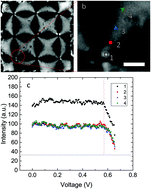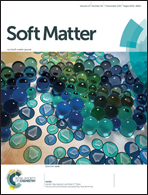Decomposition vs. escape of topological defects in a nematic liquid crystal
Abstract
Nematic cells patterned with square arrays of strength m = ±1 topological defects were examined as a function of cell thickness (3 < h < 7.5 μm), temperature, and applied voltage. Thicker cells tend to exhibit an escape or partial escape of the nematic director as a means of mitigating the elastic energy cost near the defect cores, whereas thinner cells tend to favor splitting of the integer defects into pairs of half-integer strength defects. On heating the sample into the isotropic phase and cooling back into the nematic, some apparently split defects can reappear as unsplit integer defects, or vice versa. This is consistent with the system's symmetry, which requires a first order transition between the two relaxation mechanisms.



 Please wait while we load your content...
Please wait while we load your content...